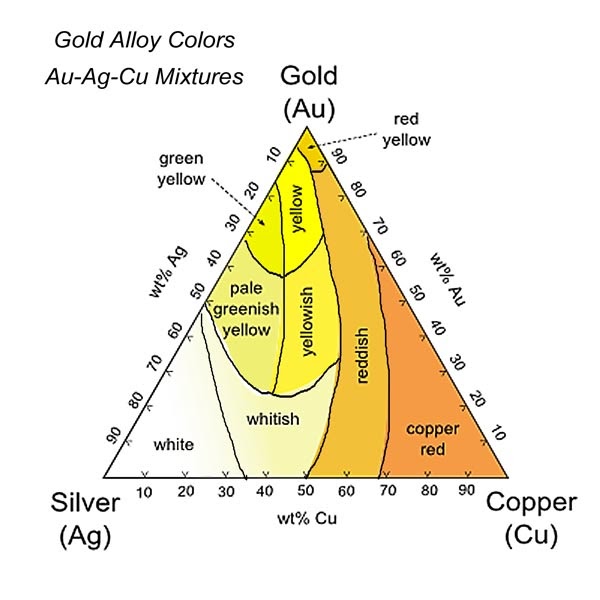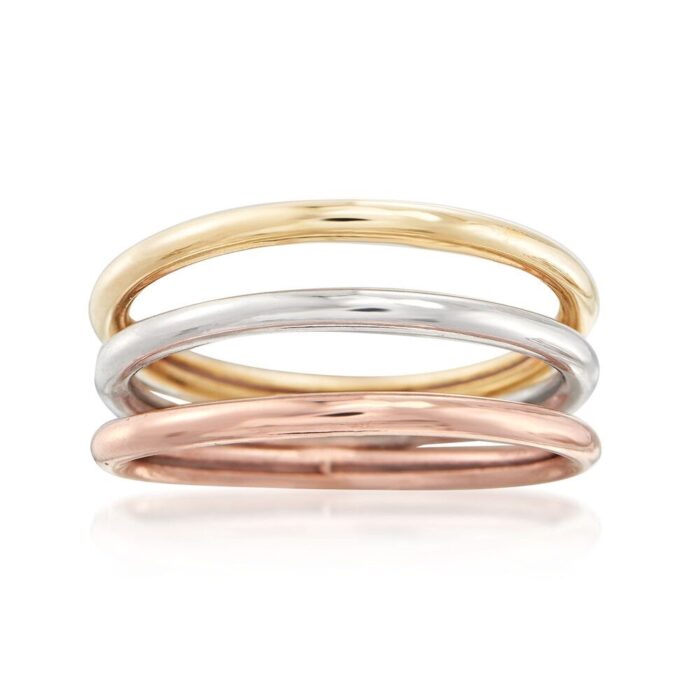What Are The Different Shades Of Gold?
Different shades of gold come into and out of fashion. Blending of gold with other alloys allows for a spectrum of options when it comes to colors, durability, and costs, all of which can get a bit confusing when buying or selling gold.
It’s not uncommon for a piece to go out of style or for your own preferences to outgrow it, in which case you’re probably looking to sell or trade in your jewelry for something you’d use.
Gold pricing seems simple on the surface, with its inherent value typically representing its value as jewelry too. Each piece has a wholesale value of the gold in it. But with many different shades of gold, different karats of gold, plating, and the inclusion of other jewels making that calculation can be difficult.
This guide will teach you the popular options when it comes to different shades of gold, how they’re produced, and what their value is.
The Different Shades Of Gold
First and foremost, it’s important to understand that gold jewelry is almost never made out of pure gold — it is too soft to be used as such — but rather, gold is combined with alloys. While your gold jewelry does include genuine gold, it’ll be mixed with something else to strengthen it and increase its lifespan.
It also makes it less expensive per unit of weight since the alloys are worth significantly less than gold.
Gold can be alloyed with a number of other metals — most often silver, copper, zinc, palladium, and nickel. Depending on what alloys are combined with the gold, different gold shades and colors are created.
Consider the following graph:

The graph shows the percentage of the mixture between the metals that will result in different shades of gold. While the most common colors you find gold in are yellow, white, rose, and green, you can actually break down gold into at least eight shades.
1. White Gold
White gold is the result of mixing gold with platinum. Gold mixed with palladium, nickel, cadmium and zinc also produce white gold. Gold in this color is more durable and scratch-resistant than yellow gold, and at the same time, it is also more affordable than both yellow gold and platinum. Rhodium plating is often used to polish up white gold jewelry that have naturally off-white shades.
2. Yellow Gold
Yellow gold is often what people think of when they think “gold” — after all, it is it’s natural color. It is made by mixing pure gold with silver, copper, and zinc. The addition of the other metals allows the yellow gold to keep its color while also becoming strong enough for jewelry use. It is the most hypo-allergenic, and requires the least maintenance of all the gold colors.
3. Rose Gold
Copper is the cause for gold taking on a rose/pink tint, though the alloy also uses a bit of silver. Due to its usage of inexpensive copper as the base for the rose color, rose gold is more affordable than the other shades of gold. The copper content also makes rose gold more durable than yellow or white gold. Rose gold is also known as Russian gold due to its popularity in Russia in the early 19th century.
4. Green Gold
Electrum is a naturally occurring alloy of silver and gold, and it is what we now refer to as green gold. It’s color is more of a greenish-yellow than a straight green. Silver is what gives green gold its color in modern compositions, though sometimes copper is added as well. Cadmium can also be added to gold alloys to create a green color, but it comes with health concerns, as cadmium is quite toxic.
5. Grey Gold
Something of an alternative to white gold, grey gold alloys are most often made from gold and palladium. There are cheaper, alternative versions of grey gold which do not use palladium, but rather silver, manganese, and copper added to the gold in specific ratios. Some forms of grey gold also use iron in the alloy mixture.
6. Purple Gold
Purple gold — also known as amethyst gold and violet gold — is an alloy of gold and aluminium. It is more brittle than other gold alloys, as it is an intermetallic compound instead of a malleable alloy, and it can be shattered by a sharp blow. This is why purple gold is never used by itself in jewelry; it’s encrusted in more conventional gold jewelry.
7. Blue Gold
Another kind of exotic gold color, blue gold is often the result of an alloy of gold and either gallium or indium. Blue gold can also be created through an alloy of gold, iron, and nickel which is then heat treated in order to oxidize the iron and obtain a superficial blue color.
8. Black Gold
While it is a rare sight to see, black gold is still the most used of exotic golds. It can be produced through a number of methods, such as patination by applying sulfur- and oxygen-containing compounds, controlled oxidation of gold containing chromium or cobalt, and more.
Despite all these shades of gold out there, yellow, white and rose golds are the most commonly used. While yellow’s popularity has taken a dip due to the increase of gold prices (since it is often a higher percentage of gold), all three remain widely used for all sorts of jewelry.

However, for some time more than a decade now, white gold has been quite popular, making its way into everything from wedding and engagement rings to casual jewelry. Though more recent trends show that it’s rose gold that is on the rise and making a name for itself.
Prices & Selling Different Shades of Gold
The rising popularity of white and rose gold rings and other jewelry might mean that you might want to trade in your older, yellow gold rings to get yourself something more up-to-date.
When you’re looking to sell your jewelry, what matters most is the composition of the jewelry. We’ve talked about the importance of purity – the amount of actual gold in a piece – in length when it comes to the value of gold. But the other alloys that comprise the piece also matter in pricing.
Most alloys are virtually worthless, so you can price the jewelry solely based on the amount of gold in it. Compared to gold’s price of near $1900/oz (October 2020), silver is worth $23.64/oz. That’s between 1-2% of gold’s value, so gold blended evenly with silver would be worth the value of the gold plus only 1-2%.
Platinum, palladium, and rhodium, are actually quite valuable. So if you have gold that is blended with one of those alloys, their valuable could be important in determining the value of your gold jewelry.
Selling Gold Online
If you want to sell your gold but don’t know how? At Express Gold Cash, we buy everything from broken gold jewelry to all sorts of gold rings and other jewelry. We’ll analyze the composition of your gold (whether it’s yellow or white or blue), determine its gold purity, identify any other valuable metals or gems, and then provide you with a free, no obligation offer.
Our process is extremely easy and convenient. You can even sell your gold without leaving your home. We’ll mail an insured package, schedule a FedEx pickup, and handle both offers and payments online. The whole process can even take less than 24 hours!
A significant benefit of selling gold to us is that we pay up to 90% of the value of gold bullion and up to 85% of the refined value of gold jewelry whereas other gold exchanges may pay significantly less. We’re always open and upfront about what we pay ahead of time so you can estimate the payout you’ll receive for your gold before even sending us the gold.
By selling your unwanted gold now and taking advantage of the current high in gold prices, you can find yourself with enough money to buy yourself rose gold or white gold jewelry — which is both cheaper, stronger, and more popular — and still have some money left over. Request a kit to get started now!




